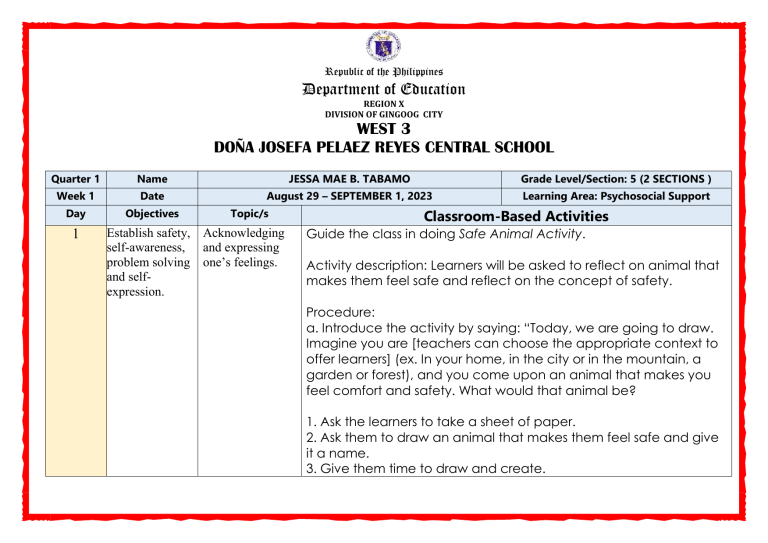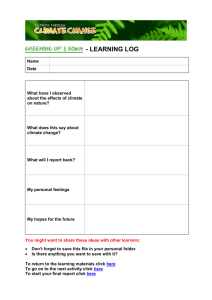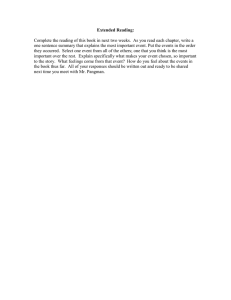
Republic of the Philippines Department of Education REGION X DIVISION OF GINGOOG CITY WEST 3 DOÑA JOSEFA PELAEZ REYES CENTRAL SCHOOL Quarter 1 Name JESSA MAE B. TABAMO Grade Level/Section: 5 (2 SECTIONS ) Week 1 Date August 29 – SEPTEMBER 1, 2023 Learning Area: Psychosocial Support Day Objectives 1 Topic/s Establish safety, Acknowledging self-awareness, and expressing problem solving one’s feelings. and selfexpression. Classroom-Based Activities Guide the class in doing Safe Animal Activity. Activity description: Learners will be asked to reflect on animal that makes them feel safe and reflect on the concept of safety. Procedure: a. Introduce the activity by saying: “Today, we are going to draw. Imagine you are [teachers can choose the appropriate context to offer learners] (ex. In your home, in the city or in the mountain, a garden or forest), and you come upon an animal that makes you feel comfort and safety. What would that animal be? 1. Ask the learners to take a sheet of paper. 2. Ask them to draw an animal that makes them feel safe and give it a name. 3. Give them time to draw and create. 4. Then ask the learners to draw a habitat for their safe animal— where will the animal live? 5. Once everyone has finished, ask if anyone would like to share their artwork with the class. 6. Let them tell their story. Prompt: -Tell us the story of your animal. - What is his/her name and where does he/she live? -ask the learner what the animal is, the contents of the safe place. Add additional questions if necessary. Wrap Up Discussion: - Talk about the importance of safety and what steps they can take when they don’t feel safe in their bodies or in their environment. - Stress that the most important thing they need to know to help them feel safe is they need to run to safety (in case of physical safety) and find an adult. On case of unsafety emotionally or in their bodies, they need to tell an adult they can trust (at home or in school) when they do not feel safe in their bodies. - 2 Establish safety, selfawareness, problem solving and selfexpression. Acknowledging Guide the class in doing Desert Island and expressing one’s feelings. Activity description: Learners will be asked to reflect on what they need for safety and survival Procedure: a. Introduce the activity by saying: 'Today we are going to create a group sculpture using natural materials or recycled materials. 1. Divide learners into groups (consider physical distancing). They will be working in a circle. 2. As they ore standing in their groups of four, say, “Imagine you are on a deserted island, and there is water all around you. What will you need to be safe there? What would you need to survive?" 3. instruct the learners to use masking tape or string) If learners are outside, they can draw on the ground to make their pretend island to create an imaginary island at the center of the circle. 4. When their islands are ready, give learners fifteen minutes to scout the room or school for “found” objects they can use for their group sculpture. 5. When they return, allow the groups to create their islands with everything they need to feel safe and to survive, using recycled or natural objects to represent these. 6. They can also use paper and pens to draw some items or people they are unable to represent through their natural or found objects. 7. When the learners are finished, let them give their island sculpture a title and put this at the base of their sculpture. 8. When everyone has finished, let the class roam around (in silence) looking at the various sculptures. Remind the learners to respect and hold judgement, and instead be curious and appreciative. 9. Let them know they can share their work with the class if they would like to. Groups can assign a leader to speak or have each member tell the story of their sculpture. Prompt: - What is the title of your piece? - Tell us about each item your desert island and how each one helps you to survive and or feel safe. Wrap Up Discussion: - Talk about the importance of safety and what steps they can take when they don’t feel safe in their bodies or in their environment. - Stress that the most important thing to tell another adult they can trust (at home or in school) when they do not feel safe. For older learners, you may want to discuss the referral system or protocol for reporting any unsafe incidents. - To close, you may ask the learners how it was working with their classmates to keep their island safe. 3 Establish safety, selfawareness, problem solving and selfexpression. Practicing Self- Guide the class in doing There’s An Emergency awareness, selfconfidence, and Activity description: This role play for emergency situations self-regulations can be a dry run for an actual situation. Teacher needs to watch out for learners who may get triggered. Pre-Activity: Think of several emergency situations that you can present to your learners. Be careful not to touch on a situation that may be very triggering for a learner. While this can sometimes be hard to avoid, be prepared with water and an exercise to help ground anyone who might be triggered. Procedure: 1. Let the learners know that they are safe with you. 2. Do a grounding/ breathing exercise. 3. Let them know that you are going to practice handling emergency situations to prepare them in case something happens. 4. On the blackboard, write down the names and numbers of people to contact in case of an emergency situation. Explain that an emergency is one where you are being constantly emotionally hurt (ex. Bullying) 5. Ask the learned to write these in their notebooks. 6. Share with them a specific example: e.g. in case of an earthquake or if someone in school is physically hurt and needs to go to the hospital, What should they do? Discussion Guide: Emphasize: -Keeping safe in school and at home is important -Physical safety means getting to a safe place or helping someone feel safe in their bodies. -Emotional safety means feeling free to be yourself in school and at home without someone putting you down. Discipline is necessary at school and at home but bullying is not. Wrap Up Discussion: -What did you learn today? -What would you do to call for help? -In school, id a classmate or someone is in trouble, who would you contact or call? 4 Establish Acknowledging Guide the class in doing Feelings Circle safety, selfand expressing awareness, one’s feelings. Activity description: Learners are invited to reflect on how feelings can exist simultaneously and deepen their self-awareness. selfunderstanding, Pre-Activity: and empathy Ask the learners if they have ever felt more than one feeling at once. Share with them that this is normal, especially in the time of COVID-19. To deal with hard feelings, tell them that it’s helpful to stop from time to time, and try to understand which are the different feelings they are experiencing. Procedure: 1. On a sheet of paper, ask learners to think of the different feelings they have at this moment. Ask them to take a sheet of paper and divide it in half. On the left side, ask them to write down all the feelings they feel in the moment and assign a color for each. 2. On the right sheet of the same paper, ask learners to create a circle. If learners have not been introduced to circular charts, you can introduce the activity by saying “Now we are making a feelings wheel and we will divide the wheel according to how much you feel each feeling you’ve written down today” 3. Ask learners to divide the wheel according to “percentages” or to the size of each feeling they are experiencing at the moment. When the learners are done, the teacher can invite them to sit in a circle in groups of four (considering physical distancing) to share their Feelings Wheel. Discussion Guide: - Who would like to share their Feelings Wheel? -What would you like to say about your Feelings Wheel? -What did you discover about yourself as you were making it or as you look at the chart now? -What did you learn about yourself? Wrap Up Discussion: - What did you learn about yourself, and about your feelings today? -What did you learn from your classmates? -What resources do you have to deal with your feelings? Discuss how it’s important to identify their feelings in order to deal with them. Sharing their story with a trusted friend or adult, sing a song, taking a walk, taking a nap, exercising, are among many different ways to help them feel better about difficult feelings. It is important to share the more uplifting feelings as well; it’s one way to support others and build friendships. 5 Establish Acknowledging Guide the class in doing Feelings Charades safety, selfand expressing Activity description: Learners are invited to reflect on how awareness, one’s feelings. we can act differently or similarly to different life situations. selfunderstanding, Pre-Activity: Prepared by the Teacher and empathy 1. Copy each of these on small piece of paper. 2. Place them folded in a box or basket. Procedure: 1. Divide the learners into teams; you may have w or more teams depending on the size of your class. 2. Ask for a volunteer timer to keep the time to 2 minutes per round. 3. Each member of each team gets to pick and act out a situation for the other team. Th other team guesses. Discussion Guide: - What was it like to act out various feelings? - What did you learn about yourself as you reacted to different situations? -What did you learn about your peers’ feelings in different situations? -How can we support each other especially during difficult times? Wrap Up Discussion We all have our own responses to different things depending on our experiences growing up. It’s important for us to respect other people’s feelings and show empathy And support especially when they are experiencing difficulty. Support can come in the form of mere presence, or letting them know that you are there as a friend. Prepared by: JESSA MAE B. TABAMO T2 Noted: LINA A. ABELLANA Principal II

